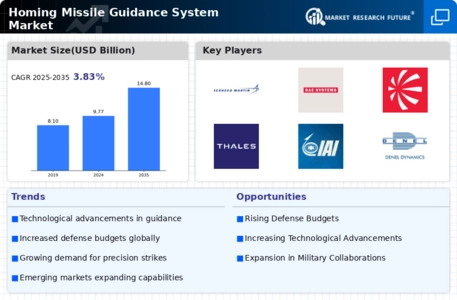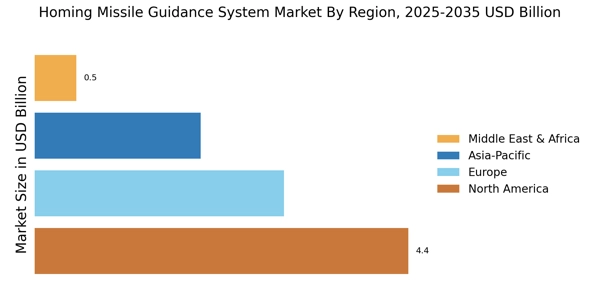Increased Defense Spending
The Homing Missile Guidance System Market is benefiting from a notable increase in defense spending across various nations. Governments are prioritizing military modernization and enhancing their defense capabilities, which includes investing in advanced missile systems. According to recent reports, defense budgets in several countries have seen an uptick, with allocations specifically earmarked for research and development in missile technology. This financial commitment is likely to drive demand for sophisticated homing missile guidance systems, as military forces seek to maintain a technological edge over potential adversaries. Furthermore, the geopolitical landscape, characterized by rising tensions and conflicts, is prompting nations to bolster their defense arsenals. Consequently, this increased spending is expected to fuel growth in the homing missile guidance system market, as countries strive to enhance their operational readiness and strategic deterrence.
Integration of Unmanned Systems
The Homing Missile Guidance System Market is increasingly shaped by the integration of unmanned systems into military operations. The rise of drones and unmanned aerial vehicles (UAVs) has transformed the battlefield, necessitating the development of advanced homing missile guidance systems that can effectively target these platforms. As military forces adopt unmanned systems for reconnaissance and strike missions, the demand for precision-guided missiles capable of engaging these targets is expected to grow. Reports indicate that the market for UAVs is projected to expand at a compound annual growth rate of over 7%, which in turn is likely to drive the need for compatible homing missile guidance systems. This integration not only enhances operational capabilities but also reflects a broader trend towards automation and advanced technology in modern warfare.
Shift Towards Precision Warfare
The Homing Missile Guidance System Market is witnessing a paradigm shift towards precision warfare, which emphasizes the need for highly accurate and reliable missile systems. This shift is driven by the desire to minimize collateral damage while maximizing operational effectiveness. As military strategies evolve, there is a growing emphasis on the use of precision-guided munitions, which rely heavily on advanced guidance systems. The demand for such systems is reflected in the increasing procurement of homing missiles equipped with state-of-the-art guidance technologies. Reports indicate that the market for precision-guided munitions is expected to expand significantly, with projections indicating a growth rate of approximately 6% annually. This trend underscores the importance of homing missile guidance systems in modern military operations, as they play a critical role in achieving strategic objectives with minimal unintended consequences.
Emerging Threats and Security Concerns
The Homing Missile Guidance System Market is significantly influenced by emerging threats and evolving security concerns. As geopolitical tensions rise and new forms of warfare emerge, nations are compelled to enhance their defense capabilities. The proliferation of advanced missile technologies among potential adversaries has heightened the urgency for countries to invest in robust homing missile guidance systems. This is particularly evident in regions experiencing instability, where the need for effective deterrence is paramount. Analysts suggest that the market for homing missile guidance systems could see substantial growth as defense forces adapt to counter these threats. The focus on developing systems that can effectively engage a variety of targets, including those posed by unmanned aerial vehicles and cruise missiles, is likely to drive innovation and investment in this sector.
Technological Advancements in Guidance Systems
The Homing Missile Guidance System Market is experiencing a surge in technological advancements, particularly in sensor technology and artificial intelligence. These innovations enhance the accuracy and reliability of missile systems, allowing for improved target acquisition and engagement. For instance, advancements in infrared and radar guidance systems have led to more effective homing capabilities, which are crucial in modern warfare scenarios. The integration of machine learning algorithms into guidance systems is also noteworthy, as it enables missiles to adapt to dynamic environments. As a result, the market is projected to grow significantly, with estimates suggesting a compound annual growth rate of over 5% in the coming years. This trend indicates a robust demand for advanced guidance systems, reflecting the military's focus on precision and effectiveness in combat operations.


















Leave a Comment